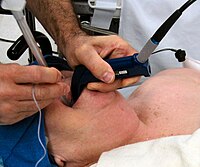
Photo from wikipedia
BackgroundPrevious studies have demonstrated that the common laryngoscopic approach (right-sided) and midline approach are both used for endotracheal intubation by direct laryngoscopy. Although the midline approach is commonly recommended for… Click to show full abstract
BackgroundPrevious studies have demonstrated that the common laryngoscopic approach (right-sided) and midline approach are both used for endotracheal intubation by direct laryngoscopy. Although the midline approach is commonly recommended for video laryngoscopy (VL) in the clinic, there is a lack of published evidences to support this practice. This study aimed to evaluate the effects of different video laryngoscopic approaches on intubation.MethodsTwo hundred sixty-two patients aged 18 years who underwent elective surgery under general anaesthesia and required endotracheal intubation were included in the present prospective, randomized, controlled study. The participants were randomly and equally allocated to the right approach (Group R) or midline approach (Group M). All the intubations were conducted by experienced anaesthetists using GlideScope video laryngoscopy. The primary outcomes were Cormack-Lehane laryngoscopic views (CLVs) and first-pass success (FPS) rates. The secondary outcomes were the time to glottis exposure, time to tracheal intubation, haemodynamic responses and other adverse events. Comparative analysis was performed between the groups.ResultsFinally, 262 patients completed the study, and all the tracheas were successfully intubated. No significant differences were observed in the patient characteristics and airway assessments (P > 0.05). Compared with Group R, Group M had a better CLV (χ2 = 14.706, P = 0.001) and shorter times to glottis exposure (8.82 ± 2.04 vs 12.38 ± 1.81; t = 14.94; P < 0.001) and tracheal intubation (37.19 ± 5.01 vs 45.23 ± 4.81; t = 13.25; P < 0.001), but no difference was found in the FPS rate (70.2% vs 71.8%; χ2 = 0.074; P = 0.446) and intubation procedure time (29.86 ± 2.56 vs 30.46 ± 2.97, t = 1.75, P = 0.081). Between the groups, the rates of hoarseness or sore throat, minor injury, hypoxemia and changes in SBP and HR showed no significant difference (P > 0.05).ConclusionAlthough the FPS rate did not differ based on the laryngoscopic approach, the midline approach could provide better glottis exposure and shorter times to glottis exposure and intubation. The midline approach should be recommended for teaching in VL-assisted endotracheal intubation.Trial registrationThe study was registered on May 18, 2019 in the Chinese Clinical Trial Registry (ChiCTR1900023252).
Journal Title: BMC Anesthesiology
Year Published: 2019
Link to full text (if available)
Share on Social Media: Sign Up to like & get
recommendations!